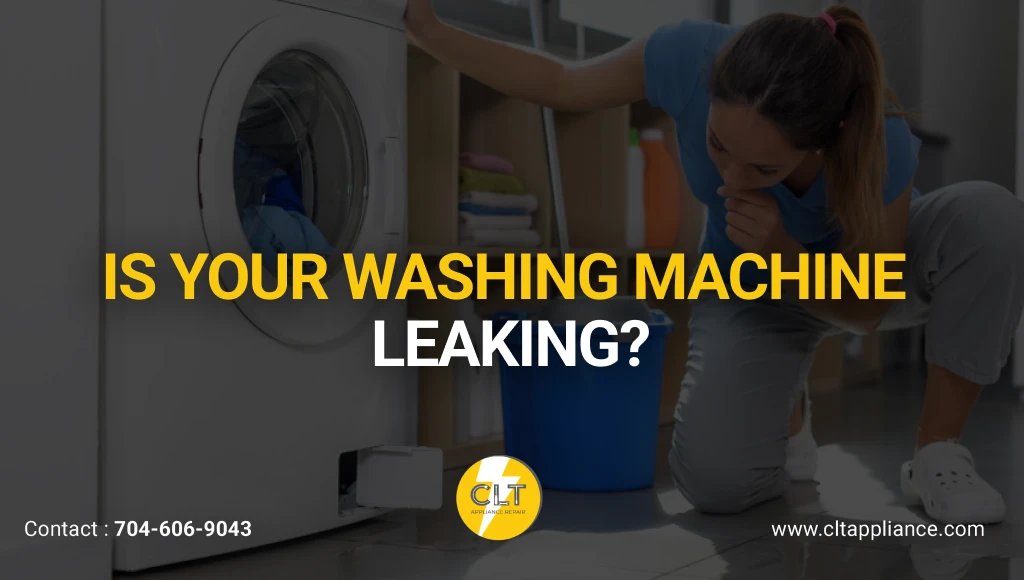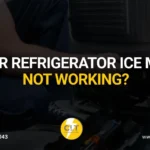[TL;DR]
Washing machine leaks can cause serious water damage if not addressed quickly. The most common causes include loose hoses, damaged door seals, clogged drain filters, and detergent dispenser problems.
- Check hoses, door seals, and dispensers for visible damage
- Use towels to identify the exact leak location during wash cycles
- Tighten connections and clean filters as first steps
- Replace worn parts like gaskets or hoses when cleaning doesn’t work
Most leaks can be fixed with basic tools and replacement parts, but internal tub damage or complex pump issues require professional repair services.
Water pooling around your washing machine is not only annoying, it’s a warning sign that could lead to expensive floor damage and costly repairs. A Washing Machine Leaking creates immediate problems that get worse every day you wait. Whether it’s a small drip or a steady stream, that water threatens your floors, walls, and nearby appliances. Most leaks start small but quickly turn into flooding disasters that destroy flooring and create mold problems. The good news? Most leaking issues can be fixed with simple tools and basic knowledge once you know what to look for.
Protect your home from water damage with our emergency leak repair services. Our certified technicians respond quickly to prevent flooding and costly repairs.
Get Emergency Leak Repair: 704-606-9043
What Causes Washing Machines Leaking?
Washing machine leaks stem from seven main problem areas that account for 95% of all leak issues. These include damaged hoses, faulty seals, clogged filters, dispenser problems, tub damage, drain issues, and valve malfunctions. Understanding these causes helps you identify and fix problems before they worsen.
Over 11,000 diagnoses on defective washing machines found that recurring failures most commonly involved electronics, shock absorbers and bearings, doors, carbon brushes, and pumps. The average service lifetime of washing machines not repaired by professional operators was 12.6 years.
Damaged or Worn Water Inlet Hoses
Water inlet hoses connect your washing machine to the water supply and experience constant pressure during operation. Over time, rubber deteriorates and connections loosen.
Signs of hose problems:
- Visible cracks or bulges in the rubber
- Water is pooling behind the machine
- Loose connections at the wall or machine attachment points
- Age over 5 years (replacement recommended)
Faulty Drain Pump or Drain Hose Problems
The drain system removes dirty water from your machine after each cycle. Clogs, loose connections, or pump failures cause water to back up and leak.
Common drain issues include:
- Lint buildup is blocking water flow
- Loose clamps on the drain hose connections
- Cracked or kinked drain hoses
- Internal pump mechanism failures
Torn or Loose Door Seal (Gasket)
Front-loading washers use rubber door seals to prevent water from escaping during cycles. These gaskets face wear from detergent buildup and regular use.
Door seal problems show as:
- Water leaks from the front during cycles
- Visible tears or holes in the rubber gasket
- Mold or detergent buildup on the seal
- The door is not closing properly or securely
Clogged or Broken Drain Filter
Most washing machines include drain filters that catch lint, coins, and debris. Clogged filters force water to find alternative escape routes.
Filter problems cause:
- Slow drainage during spin cycles
- Water is backing up into the drum
- Strange noises during drainage
- Visible debris around the filter area
Malfunctioning Detergent Dispenser
Detergent dispensers can crack, clog, or develop loose connections that allow water to leak during fill cycles.
Dispenser issues include:
- Cracked plastic compartments
- Clogged dispensing holes
- Loose mounting hardware
- Excessive suds from too much detergent
Defective Tub or Tub Seal
Internal tub damage represents serious structural problems that typically require professional repair or machine replacement.
Tub problems manifest as:
- Water leaks from underneath during any cycle
- Rust stains around the machine base
- Unusual vibrations or grinding noises
- Visible cracks in the outer tub
Issues with the Solenoid Valve
Solenoid valves control water flow into your machine. When they fail, water continues flowing even when it should stop.
Valve problems create:
- Continuous water filling
- Water leaks when the machine is off
- Irregular fill levels during cycles
- Electrical buzzing sounds from the valve area
How to Diagnose Where the Leak is Coming From
Proper leak diagnosis saves time and money by targeting the exact problem area. Follow systematic inspection steps to identify the leak source accurately.
Visual Inspection Tips (Hoses, Door Seal, Dispenser)
Start with external components that are easily accessible and commonly fail.
Inspection checklist:
- Check all hose connections for moisture or mineral deposits
- Examine the door seal for tears, mold, or debris buildup
- Look for cracks or damage in the detergent dispenser
- Inspect the area around the drain filter for wetness
Checking for Leaks During Different Wash Cycles
Run your machine through different cycles while observing when leaks occur.
Cycle-specific leak patterns:
- Fill cycle leaks indicate inlet hose or valve problems
- Wash cycle leaks suggest door seal or tub issues
- Drain cycle leaks point to pump or drain hose problems
- Spin cycle leaks often result from loose connections
Using Towels or Paper to Spot the Leak Location
Place dry towels or paper around suspected leak areas to pinpoint exact locations.
Towel placement strategy:
- Place towels behind the machine for hose leaks
- Position the towels under the front door seal for issues
- Set towels near the drain area for pump problems
- Use colored towels to make wet spots more visible
When to Call a Professional
Certain leak types require professional expertise and specialized tools.
Professional help needed for:
- Internal tub or pump replacements
- Electrical component failures
- Multiple simultaneous leak sources
- Warranty-covered repairs
Step-by-Step Fixes for Washing Machine Leaks
Most Washing Machine Leaking problems can be resolved with basic tools and replacement parts. Follow these systematic repair approaches for common issues.
Replacing or Tightening Inlet and Drain Hoses
Hose problems account for 40% of washing machine leaks and are often the easiest to fix.
Repair steps:
- Turn off the water supply valves
- Unplug the washing machine
- Check hose connections with pliers
- Replace hoses showing cracks or bulges
- Use new washers when reconnecting
- Test connections by running a small load
Cleaning or Replacing the Drain Pump and Filter
Clean drain systems prevent most drainage-related leaks.
Cleaning process:
- Locate and remove the drain filter
- Clean lint and debris from the filter
- Check the pump area for clogs or damage
- Replace the filter and test the drainage
- Run an empty cycle to verify proper operation
Repairing or Replacing the Door Seal
Door seal maintenance prevents front-loading washer leaks.
Seal repair steps:
- Clean the existing seal with a mild detergent
- Inspect for tears or permanent damage
- Remove and replace damaged seals
- Ensure proper gasket alignment during installation
- Test door closure and seal integrity
Clearing Clogs in the Detergent Dispenser
Dispenser maintenance prevents overflow leaks and improves washing performance.
Cleaning procedure:
- Remove the detergent dispenser drawer completely
- Rinse with warm water to remove buildup
- Use an old toothbrush for stubborn deposits
- Check the dispenser housing for cracks
- Replace damaged dispensers with exact matches
Replacing a Faulty Tub Seal or Solenoid Valve
Internal component repairs require mechanical skills and proper tools.
Professional replacement recommended for:
- Tub seal installations requiring machine disassembly
- Solenoid valve electrical connections
- Internal pump component access
- Warranty preservation requirements
Leveling the Washing Machine Properly
Proper leveling prevents water spillage and reduces wear on internal components.
Leveling steps:
- Use a bubble level on top of the machine
- Adjust individual leg heights as needed
- Ensure all four legs contact the floor firmly
- Test stability during spin cycles
- Recheck the level after moving or maintenance
Avoiding Overloading to Prevent Leaks
Overloading creates excessive vibration and strain on seals and connections.
Load management:
- Follow the manufacturer’s capacity guidelines
- Distribute clothing evenly in the drum
- Use appropriate water levels for the load size
- Avoid washing single heavy items alone
Preventive Tips to Avoid Future Leaks
Regular maintenance prevents 80% of washing machine leaks and extends appliance lifespan. Implement these preventive measures to avoid future problems.
Regular Maintenance Checks
Schedule monthly inspections of key components to catch problems early.
Monthly checklist:
- Inspect hoses for wear or damage
- Clean door seals and dispensers
- Check and clean the drain filter
- Verify machine-level and stability
- Test all cycle functions
Proper Detergent Usage and Load Sizes
Correct detergent amounts prevent overflow and reduce seal wear.
Best practices include:
- Use high-efficiency detergent for HE machines
- Measure detergent according to load size
- Avoid fabric softener in dispenser-only machines
- Clean dispensers monthly to prevent buildup
Ensuring the Machine is Level and Stable
Level machines operate efficiently and experience less component wear.
Stability requirements:
- Check the level quarterly or after moving
- Tighten leg adjustments if loosened
- Use anti-vibration pads on hard floors
- Maintain proper clearance from walls
Scheduling Professional Inspections Periodically
Professional maintenance identifies potential problems before they cause leaks. Washing machine ownership reaches 70% of homes in the United States, with even higher rates in countries like Germany, Spain, the UK, Canada, Japan, and Turkey. This widespread ownership underscores the importance of proper maintenance and leak prevention.
Professional service includes:
- Internal component inspection
- Electrical system testing
- Calibration of water levels and timing
- Replacement of wear items before failure
Maintenance Benefits: Homes with properly maintained washing machines experience fewer emergency repair calls and avoid costly appliance-related water damage through regular upkeep and prompt attention to early warning signs.
Takeaway
Washing machine leaks range from simple hose connections to complex internal component failures. Most homeowners can handle basic repairs like tightening connections, cleaning filters, and replacing external hoses. However, internal damage, electrical issues, and warranty considerations often require professional expertise.
Quick action prevents minor leaks from becoming major water damage. Regular maintenance, proper use, and periodic professional inspections keep your washing machine running reliably while protecting your home from costly water damage.
CLT Appliance Repair delivers fast, reliable washing machine leak solutions for your home. Our certified technicians handle everything from simple hose fixes to complex internal repairs.
Don’t let small leaks become flooding disasters. Contact the local experts who prioritize your home’s protection.
Contact CLT Appliance Repair Today: 704-606-9043
Frequently Asked Questions
Q1: What are the most common causes of a washing machine leaking?
Common causes include damaged or loose hoses, faulty door seals, clogged drain filters, detergent dispenser issues, and cracked tubs or drainage pipes.
Q2: How can I find where my washing machine is leaking from?
Look for water pooling near the door, back, or underneath the machine, and inspect hoses, door seals, and detergent dispensers during different wash cycles to locate the source.
Q3: Can using too much detergent cause a washing machine to leak?
Yes, excess detergent creates too many suds that can overflow, leading to leaks, especially in top-load washers.
Q4: How do I fix a leaking door seal on a front-load washing machine?
Clean the seal regularly to remove dirt and debris, check for tears or damage, and replace the door gasket if it is cracked or unsealed.
Q5: When should I call a professional to fix my leaking washing machine?
Call a professional if you notice internal leaks, damaged tubs, or if basic troubleshooting like hose tightening and cleaning doesn’t stop the leak.
Q6: Does leveling the washing machine help prevent leaks?
Yes, an unlevel machine can cause water to spill or leak, so ensure all legs are adjusted and the washer sits evenly on the floor.
Author

- John Bennett
- John Bennett is a seasoned appliance repair specialist at CLT Appliance Repair, where he brings over a decade of technical expertise and a strong commitment to customer satisfaction. With a background in electrical and mechanical systems, John has built a reputation for reliable, efficient, and honest repair services across a wide range of household appliances-including refrigerators, washing machines, ovens, and more.







